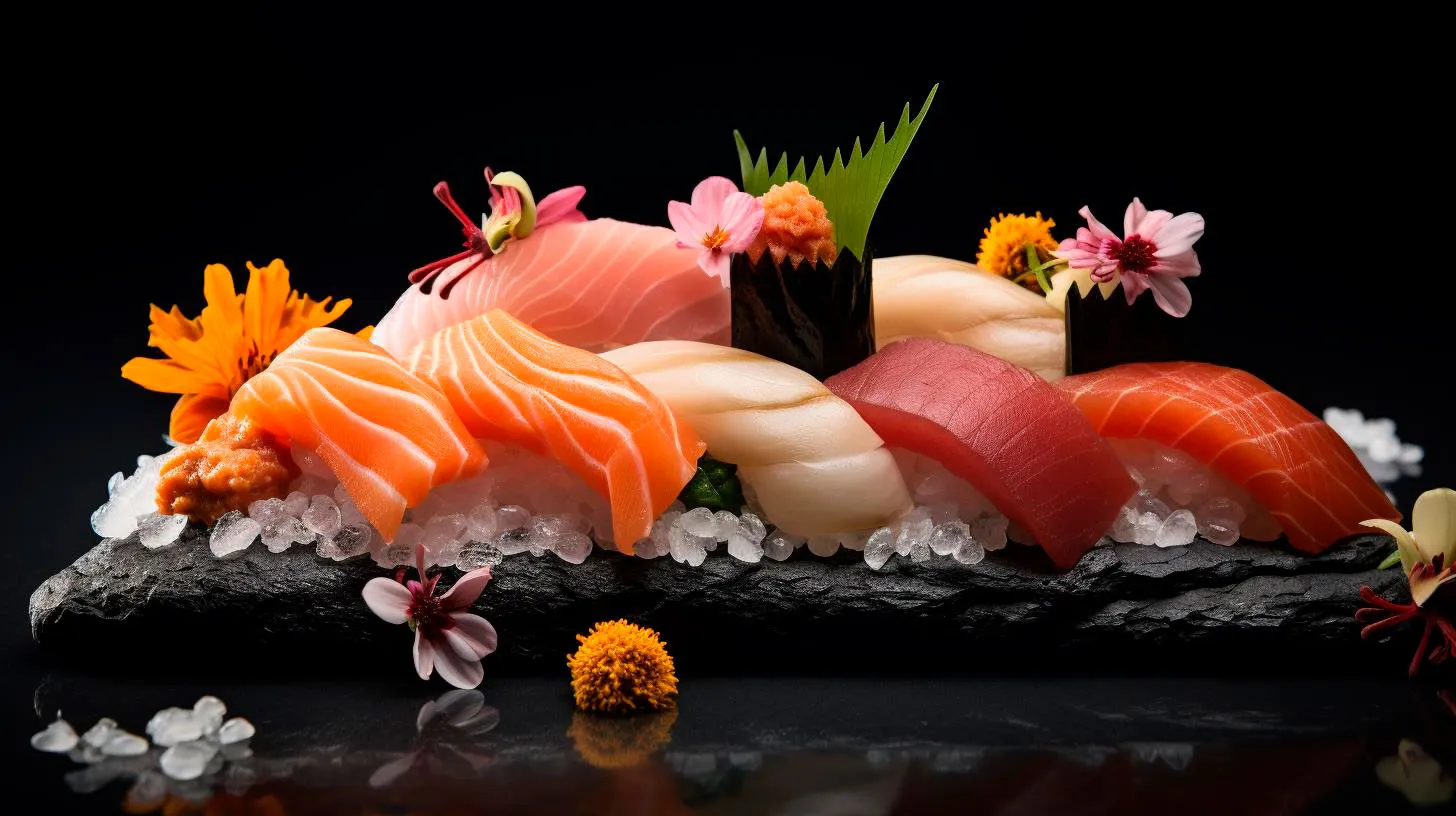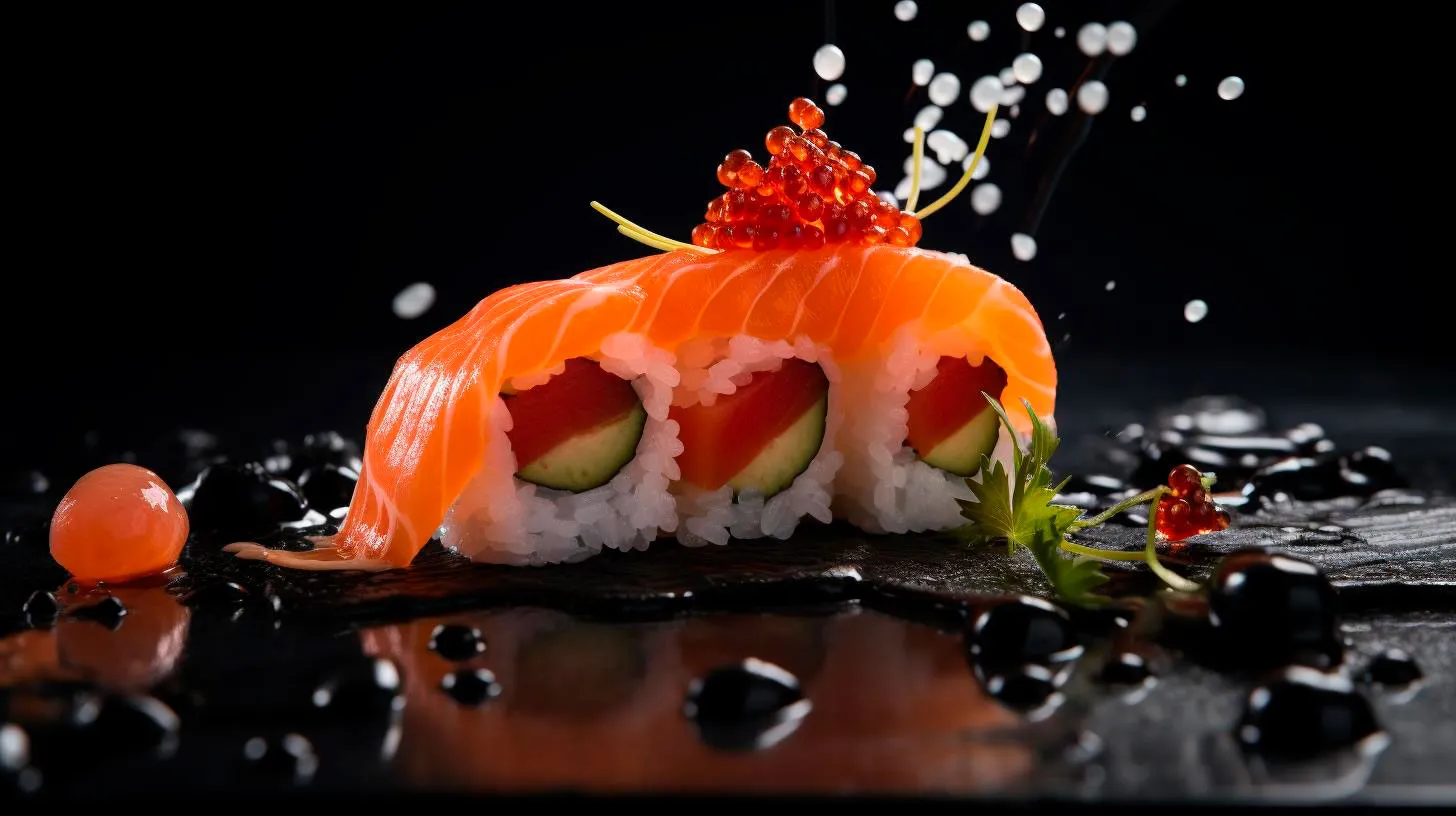Unveiling the Hidden Impact: How Sushi Allergies Affect Lives
In this article, we will explore the impact of sushi allergies on people’s lives, shedding light on this often under-discussed topic.
The Prevalence of Sushi Allergies
According to recent studies, seafood allergies affect approximately 2-3% of the global population, making it one of the most common food allergies. Among these seafood allergies, fish and shellfish allergies account for the majority. Given the popularity of sushi and its widespread consumption, sushi allergies are not as rare as one might think.
It is important to note that sushi allergies can vary in their severity. Some individuals experience mild symptoms, such as skin rashes and itching, while others may face more severe reactions that can even be life-threatening. Allergy symptoms usually appear within minutes to a few hours after consuming sushi.
The Hidden Dangers of Sushi Allergies
While sushi may seem harmless to those without allergies, for those who do have allergies, a seemingly innocent meal can have dire consequences. Here are some of the hidden dangers associated with sushi allergies:
- Cross-Contamination: Sushi restaurants often handle various seafood ingredients in the same kitchen, increasing the risk of cross-contamination. Even a small trace of an allergen can trigger an allergic reaction in sensitive individuals.
- Hidden Ingredients: Sushi may contain hidden ingredients that can be allergenic. For instance, certain types of sushi rolls are prepared with fish roe, which might not be immediately apparent to consumers. This lack of transparency can be dangerous for those with allergies.
- Cultural Barriers: Many sushi chefs may not have adequate knowledge about food allergies or the ingredients used in sushi. This can make it challenging for individuals with allergies to communicate their dietary restrictions effectively.
It is essential for sushi lovers with allergies to exercise caution and follow some key measures to ensure their safety.
Key Takeaways for Sushi Allergy Management
Suffering from sushi allergies doesn’t have to mean giving up on enjoying this beloved cuisine entirely. By taking the following precautions, individuals can still savor sushi without compromising their health:
- Communication is Key: When dining out at a sushi restaurant, clearly communicate your food allergies to the waiter or chef. This will help them understand your requirements and take necessary precautions during food preparation.
- Be Inquisitive: Don’t hesitate to ask about the ingredients used in different sushi options. Being aware of any potential allergens will allow you to make informed choices and avoid unpleasant surprises.
- Sushi Alternatives: If seafood allergies prevent you from enjoying traditional sushi, explore alternative options like vegetarian or vegetable-based sushi rolls. These can provide a delightful culinary experience without the risk of allergens.
- Home Cooking: Consider preparing sushi at home using safe ingredients that suit your dietary restrictions. This way, you have full control over the ingredients and can enjoy sushi with peace of mind.
The Future of Sushi Allergy Management
As sushi allergies continue to be a concern for many, the food industry is also stepping up its efforts to address this issue. Researchers and chefs are working towards finding innovative solutions, such as developing hypoallergenic sushi ingredients and improving allergen labeling practices.
Additionally, advancements in genetic testing might enable individuals to determine their predisposition to sushi allergies. This could help raise awareness and guide people in making informed decisions to prevent allergic reactions.
Conclusion
Sushi allergies can have a significant impact on the lives of individuals who are allergic to seafood or specific ingredients used in sushi. By understanding the prevalence of these allergies, the hidden dangers associated with sushi consumption, and implementing key measures for allergy management, those with sushi allergies can still cherish this culinary experience without compromising their health. With ongoing research and increased awareness, the future holds promise for better allergy management in sushi and the food industry as a whole.
Managing Sushi Allergies: Tips for a Safe and Enjoyable Dining Experience
In this article, we will explore some valuable tips and precautions to ensure a safe and enjoyable sushi dining experience.
Understanding Sushi Allergies
Before we dive into the tips, let’s first understand what sushi allergies are and how they can affect individuals. Sushi allergies are typically triggered by certain ingredients used in sushi preparation, such as fish, shellfish, seaweed, soy, and even gluten found in soy sauce.
Common symptoms of sushi allergies include:
- Itchy or swollen hives
- Nausea and vomiting
- Diarrhea
- Difficulty breathing or wheezing
- Dizziness or lightheadedness
If you experience any of these symptoms after consuming sushi, it is highly recommended to consult with a medical professional to determine the specific allergen causing the reaction.
Tips for Managing Sushi Allergies
Now that we have a basic understanding of sushi allergies, let’s explore some helpful tips to ensure a safe and enjoyable dining experience:
1. Communicate Your Allergy
When dining out at a sushi restaurant, it is crucial to inform the staff about your allergy. Speak to the server or the manager and clearly state your specific allergy requirements. By communicating your allergy concerns, the restaurant can take necessary precautions to minimize cross-contamination and provide you with suitable alternatives.
2. Choose Reliable Restaurants
Opt for reputable sushi restaurants known for their attention to detail in food preparation and handling allergies. Research online and read customer reviews to gauge the restaurant’s commitment to food safety. A well-regarded sushi restaurant will prioritize customer safety and accommodate allergy concerns.
3. Inquire about Ingredients
Don’t hesitate to ask the restaurant staff about the ingredients used in their sushi dishes. Be aware of common allergens in sushi, and discuss with the staff to determine if specific dishes or sauces contain any potential allergens. Most establishments will provide detailed information about their menu items upon request.
4. Avoid High-risk Options
Some types of sushi are more likely to contain common allergens than others. Take precautions by avoiding high-risk options such as sushi made with raw fish or shellfish. Instead, opt for vegetarian or cooked seafood options. Veggie rolls or sushi with cooked fish are excellent alternatives for individuals with allergies.
5. Request Customized Sushi
If you are uncertain about the ingredients in a particular sushi dish, don’t hesitate to request customized sushi. Most sushi restaurants are willing to accommodate requests and prepare sushi rolls with specific ingredients you feel comfortable with. Customization ensures you have full control over the ingredients used and reduces the risk of allergen exposure.
6. Pack Allergy Medication
Always carry your prescribed allergy medication with you when dining out. In case of accidental exposure to an allergen, immediate treatment can make a significant difference in preventing severe reactions. Consult with your healthcare provider for appropriate medication and dosage instructions.
Key Takeaways
- Inform the restaurant staff about your allergy concerns.
- Choose reputable sushi restaurants known for their attention to food safety.
- Ask about the ingredients used in sushi dishes.
- Avoid high-risk options by opting for vegetarian or cooked seafood sushi.
- Request customized sushi to have control over the ingredients.
- Carry your prescribed allergy medication at all times.
Enjoying sushi while managing allergies is absolutely possible when armed with the right knowledge and precautions. By communicating your concerns and making informed choices, you can have a safe and enjoyable sushi dining experience. Remember to prioritize your health and take the necessary steps to protect yourself while indulging in this beloved culinary delight.
Sushi Allergies and Social Situations: Navigating the Daily Challenges
In this article, we will explore the various aspects of sushi allergies and provide valuable insights on how to tackle these allergies in social settings.
The Basics of Sushi Allergies
Before we delve into the social implications, let’s understand the basics of sushi allergies. Sushi allergies primarily occur due to two main culprits: seafood and soy. These ingredients can trigger allergic reactions ranging from mild discomfort to severe complications. Seafood allergies are more common, with an estimated 7.8% of adults worldwide affected by this condition, according to the World Allergy Organization.
Tackling Sushi Allergies in Social Settings
While sushi allergies can seem daunting, with a little knowledge and preparation, you can navigate social situations with confidence. Here are some key strategies to handle sushi allergies in different scenarios:
1. Dining out at a Sushi Restaurant
- Inform the staff: When making a reservation or upon arrival, inform the restaurant staff about your allergy. This will enable them to accommodate your needs and suggest alternative options.
- Review the menu: Carefully review the menu to identify dishes that are safe for consumption. Sashimi, which does not include rice or soy, can be a good choice for seafood allergy sufferers.
- Be cautious with sauces: Soy sauce contains soy, which can trigger allergies. Ask for gluten-free or low-sodium alternatives, or bring your own sauce to ensure it is allergen-free.
2. Attending Parties or Social Gatherings
- Inform the host in advance: Letting the host know about your allergies in advance will allow them to plan and accommodate your needs or consider alternative dishes that are safe for you.
- Offer to bring a dish: Consider bringing a sushi alternative that you can enjoy and share with others. This ensures you have a safe option while also introducing others to delicious alternatives.
- Practice open communication: If you are unsure about the ingredients used in a particular dish, politely ask the host or other guests for more information. It’s better to be safe than sorry.
3. Sushi Allergies at Work Gatherings
- Notify your supervisor or HR: Inform your supervisor or human resources department about your allergies. This allows them to make arrangements for allergy-friendly food options during work-related celebrations.
- Advocate for alternative choices: Suggest alternative catering options for office events, ensuring there are dishes that cater to diverse dietary requirements, including sushi alternatives.
- Bring your lunch: If the event is potluck-style or you are unsure about the available food options, bring your own lunch to ensure a safe and enjoyable meal.
The Importance of Proper Allergy Management
Managing sushi allergies, especially in social settings, is crucial to prevent any adverse reactions. Here are some key takeaways to keep in mind:
- Always carry an epinephrine auto-injector: In case of severe allergic reactions, having an epinephrine auto-injector (such as an EpiPen) on hand can be lifesaving. Make sure it is readily accessible.
- Read labels and ingredients: Whether dining out or purchasing packaged sushi, carefully read labels and ingredient lists to identify potential allergens.
- Consult an allergist: If you suspect you have a sushi allergy, consult an allergist for proper diagnosis, advice, and medication, if necessary.
Remember, living with sushi allergies doesn’t mean you have to miss out on social occasions. With awareness, preparation, and effective communication, you can enjoy social gatherings while keeping your allergies in check.
Disclaimer: This article is for informational purposes only and should not be considered medical advice. Always consult with a qualified healthcare professional for diagnosis and treatment.
The Rise of Sushi Allergies: Understanding the Prevalence
The Growing Popularity of Sushi
Sushi has undeniably become a global culinary phenomenon. Over the past decade, the consumption of sushi has skyrocketed, with sushi restaurants popping up in every corner of major cities worldwide. According to a report by Research and Markets, the global sushi market is expected to reach a value of $22.20 billion by 2025, growing at a CAGR of 4.1% from 2020 to 2025. As more people try sushi and develop a taste for it, the incidence of sushi allergies also rises.
The Prevalence of Sushi Allergies
Although sushi allergies are not as common as other food allergies, such as peanuts or shellfish, they should not be overlooked. Allergies to sushi can be classified into two main types:
1. Fish Allergy
One common type of sushi allergy is an allergy to fish. Fish allergies are more prevalent in adults and can cause mild to severe allergic reactions. Fish proteins, such as parvalbumin, are the primary culprits behind these allergies. According to a study published in the Journal of Allergy and Clinical Immunology, fish allergies affect approximately 0.2 to 0.5% of the population globally.
Key Takeaways:
- Fish allergies are the most common type of sushi allergy.
- Parvalbumin, a fish protein, triggers allergic reactions.
- Approximately 0.2 to 0.5% of the population is affected by fish allergies.
2. Shellfish Allergy
The second type of sushi allergy is an allergy to shellfish. Shellfish allergies are more prevalent in children and can cause severe allergic reactions, including anaphylaxis. According to a study published in the Journal of Allergy and Clinical Immunology, shellfish allergies affect 0.5 to 2.5% of the global population.
Key Takeaways:
- Shellfish allergies are more common in children.
- Allergic reactions to shellfish can be life-threatening.
- About 0.5 to 2.5% of the population is affected by shellfish allergies.
Managing and Preventing Sushi Allergies
If you have a known sushi allergy or suspect you may be allergic to sushi, it is crucial to take necessary precautions to prevent allergic reactions:
- Consult an allergist: If you suspect a sushi allergy, consult an allergist for proper diagnosis and guidance.
- Read food labels: Be vigilant about reading food labels to check for potential allergens, especially fish or shellfish.
- Inform restaurant staff: When dining out at a sushi restaurant, inform the staff about your allergy so they can take necessary precautions to avoid cross-contamination.
- Carry an epinephrine auto-injector: For individuals with severe allergies, carrying an epinephrine auto-injector (such as an EpiPen) can be life-saving in case of an allergic reaction.
- Explore alternative options: If you have a sushi allergy, you can still enjoy Japanese cuisine by exploring alternative dishes such as vegetable rolls or tempura.
Conclusion
As the popularity of sushi continues to rise, so does the awareness of sushi allergies. While sushi allergies are relatively uncommon compared to other food allergies, they can still cause severe reactions in some individuals. Understanding the prevalence of fish and shellfish allergies and taking necessary precautions can help prevent allergic reactions and allow individuals with sushi allergies to continue enjoying Japanese cuisine safely.
Remember, if you suspect a sushi allergy, consult an allergist for proper diagnosis and guidance. With proper management and precautions, sushi can still be a delightful dining experience for everyone.


